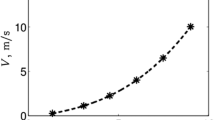Abstract
A velocity dependent effective angle (VDEA) method for the calibration of yaw response of hot-wire X-probes at low flow velocities (0.5–6 m/s) is presented. Comparisons with a full velocity vs. yaw-angle method (Österlund 1999) in a smooth wall channel flow indicate that there is only moderate advantage in using the latter method, which is considerably more laborious. Comparisons with direct numerical simulations (DNS) (Moser et al. 1999) and the more common fixed effective angle method (FEA) show that the VDEA method significantly improves estimates of Reynolds stresses compared to the FEA method.









Similar content being viewed by others
References
Bakken OM, Krogstad P-Å (2003) Stress measurements in a rough wall channel flow using a variable angle method of calibration for X-probes. In: Kasagi N, Eaton JK, Friedrich R, Humphrey JAC, Leschziner MA, Miyauchi T (eds) Turbulence and Shear Flow Phenomena-3, vol 1., Sendai, Japan, pp 105–110
Bearman PW (1971) Corrections for the effect of ambient temperature drift on hot-wire measurements in incompressible flow. DISA Info 11:25–30
Bradshaw P (1971) An introduction to turbulence and its measurement. Pergamon Press, Oxford
Browne LWB, Antonia RA, Chua LP (1989) Calibration of X-probes for turbulent flow measurements. Exp Fluids 7:201–208
Bruun HH (1995) Hot-wire anemometry: principles and signal analysis. Oxford University Press, New York
John J, Schobeiri T (1993) A simple and accurate method of calibrating X-probes. J Fluids Eng 115:148–152
Krogstad P-Å, Antonia RA, Browne LWB (1992) Comparison between rough- and smooth-wall turbulent boundary layers. J Fluid Mech 245:599–617
Maciel Y, Gleyzes C (2000) Survey of multi-wire probe data processing techniques and efficient processing of four-wire probe velocity measurements in turbulent flows. Exp Fluids 29:66–78
Moser RD, Kim J, Mansour NN (1999) Direct numerical simulation of turbulent channel flow up to Reτ=590. Phys Fluids 11(4):943–945
Oster D, Wygnanski I (1982) The forced mixing layer between parallel streams. J Fluid Mech 123:91–130
Österlund JM (1999) Experimental studies of zero pressure-gradient turbulent boundary layer flow. PhD Thesis, Royal Institute of Technology, Stockholm, Sweden
Perry AE (1982) Hot-wire anemometry. Oxford University Press, Oxford
Shabbir A, Beuther PD, George WK (1996) X-wire response in turbulent flows of high-intensity turbulence and low mean velocities. Exp Thermal Fluid Sci 12:52–56
Snyder WH, Castro IP (1998) The yaw response of hot-wire probes at ultra-low wind speeds. Meas Sci Technol 9:1531–1536
Tutu NK, Chevray R (1975) Cross-wire anemometry in high intensity turbulence. J Fluid Mech 71:785–800
Acknowledgements
The authors are grateful to Dr. Österlund for making available the source code of his calibration procedure.
Author information
Authors and Affiliations
Corresponding author
Rights and permissions
About this article
Cite this article
Bakken, O.M., Krogstad, PÅ. A velocity dependent effective angle method for calibration of X-probes at low velocities. Exp Fluids 37, 146–152 (2004). https://doi.org/10.1007/s00348-004-0798-y
Received:
Accepted:
Published:
Issue Date:
DOI: https://doi.org/10.1007/s00348-004-0798-y




